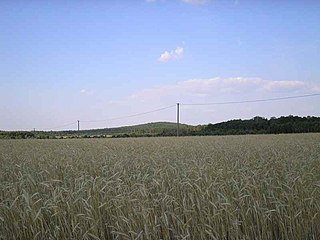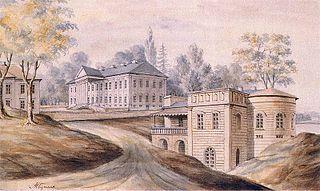
The Lublin Voivodeship, also known as the Lublin Province, is a voivodeship (province) of Poland, located in southeastern part of the country. It was created on January 1, 1999, out of the former Lublin, Chełm, Zamość, Biała Podlaska and (partially) Tarnobrzeg and Siedlce Voivodeships, pursuant to Polish local government reforms adopted in 1998. The region is named after its largest city and regional capital, Lublin, and its territory is made of four historical lands: the western part of the voivodeship, with Lublin itself, belongs to Lesser Poland, the eastern part of Lublin Area belongs to Red Ruthenia, and the northeast belongs to Polesie and Podlasie. Lublin Voivodeship borders Subcarpathian Voivodeship to the south, Świętokrzyskie Voivodeship to the south-west, Masovian Voivodeship to the west and north, Podlaskie Voivodeship along a short boundary to the north, Belarus and Ukraine to the east. The region's population as of 2019 was 2,112,216. It covers an area of 25,155 square kilometres (9,712 sq mi).

Tarnopol Voivodeship was an administrative region of interwar Poland (1918–1939), created on 23 December 1920, with an area of 16,500 km² and provincial capital in Tarnopol. The voivodeship was divided into 17 districts (powiaty). At the end of World War II, at the insistence of Joseph Stalin during the Tehran Conference of 1943 without official Polish representation whatsoever, the borders of Poland were redrawn by the Allies. The Polish population was forcibly resettled after the defeat of Nazi Germany and the Tarnopol Voivodeship was incorporated into the Ukrainian SSR of the Soviet Union. Since 1991, most of the region is located in the Ternopil Oblast in sovereign Ukraine.

The massacres of Poles in Volhynia and Eastern Galicia were carried out in German-occupied Poland by the Ukrainian Insurgent Army (UPA) with the support of parts of the local Ukrainian population against the Polish minority in Volhynia, Eastern Galicia, parts of Polesia and Lublin region from 1943 to 1945. The ruling Germans also actively encouraged both Ukrainians and Poles to kill each other. The peak of the massacres took place in July and August 1943. The massacres were exceptionally brutal and affected primarily women and children. The UPA's actions resulted in up to 100,000 deaths. Other victims of the massacres included several hundred Armenians, Jews, Russians, Czechs, Georgians, and Ukrainians who were part of Polish families or opposed the UPA and sabotaged the massacres by hiding Polish escapees.

Stryi is a city in Lviv Oblast, western Ukraine. It is located the left bank of the Stryi River, approximately 65 kilometres (40 mi) south of Lviv in the foothills of the Carpathian Mountains. It serves as the administrative center of Stryi Raion within the oblast. Stryi also hosts the administration of Stryi urban hromada, one of the hromadas of Ukraine. Its population is approximately 59,425.

Battle of Borowa Góra refers to the series of battles from 2 to 5 September 1939 that took place near the Góry Borowskie hills, south west from Piotrków Trybunalski and east of Bełchatów. The battle, fought between the Wehrmacht and the Polish Army in the vicinity of Łódź, was a direct consequence of the Battle of the Border, an early part of the German Invasion of Poland
Pohrebyshche is a small city in Vinnytsia Oblast, Ukraine. It is the administrative center of Pohrebyshche Raion (district) in western Ukraine. Pohrebyshche is situated near the sources of the Ros River. Population: 9,209.

For other towns with a similar name see Dąbrowica (disambiguation)

The Ponary massacre, or the Paneriai massacre, was the mass murder of up to 100,000 people, mostly Jews, Poles, and Russians, by German SD and SS and the Lithuanian Ypatingasis būrys killing squads, during World War II and the Holocaust in the Generalbezirk Litauen of Reichskommissariat Ostland. The murders took place between July 1941 and August 1944 near the railway station at Ponary, a suburb of today's Vilnius, Lithuania. 70,000 Jews were murdered at Ponary, along with up to 20,000 Poles, and 8,000 Soviet POWs, most of them from nearby Vilnius, and its newly formed Vilna Ghetto.

The Pomeranian Voivodeship or Pomorskie Voivodeship was an administrative unit of interwar Poland. It ceased to function in September 1939, following the German and Soviet invasion of Poland.

Chełm Land was a region of the Kingdom of Poland and later of the Polish–Lithuanian Commonwealth (1569–1795). Today, the region is situated in the modern states of Poland, Ukraine, and Belarus. As an exclave of the Ruthenian Voivodeship, it was separated from the main part of the voivodeship by the voivodeship of Bełz. The region's most important town was Chełm. In the Commonwealth, Chełm Land enjoyed a special status; some documents described it as a separate entity - Chełm Voivodeship.

The Janowa Dolina massacre took place on 23 April 1943 in the village of Janowa Dolina, during the occupation of Poland in World War II. Before the Nazi invasion of the Polish Second Republic, Janowa Dolina was a model settlement built in the Kostopol County of the Wołyń Voivodeship by workers of the Polish State Basalt Quarry. The town was inhabited by 2,500 people. Its name, which translates as the "Janow's Valley" in Polish, came from the Polish king Jan Kazimierz, who reportedly hunted in the Volhynian forests, and after hunting — rested on the shore of the Horyń (Horyn) River. The town was destroyed during World War II by the Ukrainian Insurgent Army who murdered most of its Polish population including women and children.

The Huta Pieniacka massacre was a massacre of the Polish inhabitants of the village Huta Pieniacka, located in modern-day Ukraine, which took place on February 28, 1944. Estimates of the number of victims range from 500 to 600-800 to 1,200.
The battle of Gródek Jagielloński or battle of Horodok took place during the Russo-Polish War (1654–67) on 29 September 1655. Russian and Ukrainian Cossack forces under Vasily Borisovich Sheremetev and Bohdan Khmelnytsky engaged a Polish–Lithuanian army under Stanisław "Rewera" Potocki near Gródek Jagielloński, which at that time was part of Polish–Lithuanian Commonwealth's Ruthenian Voivodeship. Polish forces were defeated and forced to retreat, losing their supplies to the Russians. The Russians advanced, besieging Lwow, and Potocki with the remains of his army was soon forced to surrender to the invading Swedes.
Kurdybań Warkowicki, or Kurdyban–Warkowicki, was a Polish village in Wołyń Voivodeship (1921–1939) before the joint Nazi German and Soviet invasions of Poland in 1939. It was located near the town of Warkowicze in Dubno County, in the eastern part of the Second Polish Republic. The village was eradicated during the Polish population transfers after World War II, when the Kresy macroregion was formally incorporated into the Soviet Union.
Kysorychi is a village located in Sarny Raion, Rivne Oblast, Ukraine, but was formerly administered within Rokytne Raion. Before the 1939 Nazi German and Soviet invasions of Poland, the village was named Kisorycze and was located in Gmina Kisorycze, Sarny County, Wołyń Voivodeship in the eastern part of the Second Polish Republic. The biggest employer in the area was a glass factory in Rokytne (Рокитне) 8 km north of town, employing 400 workers.
Pańska Dolina no longer exists. The village was liquidated during the Polish population transfers after World War II, when the Kresy macroregion was formally incorporated into the Soviet Union. Pańska Dolina used to be located in Gmina Młynów, Powiat Dubno (county), of the Wołyń Voivodeship, before the Nazi German and Soviet invasions of Poland in September 1939. Its former location can be found near Mlyniv in Dubno Raion of present-day Ukraine.

Mlyniv is an urban-type settlement in Rivne Oblast (province) in western Ukraine. Mlyniv was also formerly the administrative center of Mlyniv Raion, housing the district's local administration buildings, although it is now administrated under Dubno Raion. Its population was 8,446 as of the 2001 Ukrainian Census. The current population is 8,036.

Around 6 million Polish citizens perished during World War II: about one fifth of the pre-war population. Most were civilian victims of the war crimes and crimes against humanity during the occupation by Nazi Germany and the Soviet Union. Approximately half were Polish Jews killed in The Holocaust. Statistics for Polish World War II casualties are divergent and contradictory. This article provides a summarization of these estimates of Poland's human losses in the war and their causes.

During World War II, Trawniki men were Central and Eastern European Nazi collaborators, consisting of either volunteers or recruits from prisoner-of-war camps set up by Nazi Germany for Soviet Red Army soldiers captured in the border regions during Operation Barbarossa launched in June 1941. Thousands of these volunteers served in the General Government territory of German-occupied Poland until the end of World War II. Trawnikis belonged to a category of Hiwis, Nazi auxiliary forces recruited from native subjects serving in various jobs such as concentration camp guards.
The Battle of Chornobyl took place on 27 April 1920, near the town of Chornobyl (Chernobyl), Ukraine, during the Polish-Soviet War. It was part of the Kiev Operation of the Polish Army, and ended in Polish victory.














